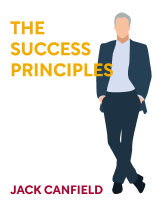

This article is an excerpt from the Shortform book guide to "The Success Principles" by Jack Canfield. Shortform has the world's best summaries and analyses of books you should be reading.
Like this article? Sign up for a free trial here .
What do you do when confronted with a major life challenge? Do you seek help from external sources (e.g. consult friends and family)? Or are you the kind of person who relies solely on internal input?
When confronted with a challenge, many people know how to seek outside help. But few know how to access their inner wisdom or intuition. You can learn how to tap into your intuition to help you make decisions.
In this article, you’ll learn how to tap into your intuition.
Tapping Into Your Intuition
You’ve likely had an experience where your intuition told you something. For example, you might have felt a prickle on the back of your neck and realized someone was looking at you. Everyone has intuition, but successful people learn how to access it at will so they can use it to their advantage. Consulting your intuition can help you solve problems, make decisions, earn money, access your creativity, and more.
There are three main ways your intuition speaks to you:
- Emotions. You may feel certain emotions that reveal the true nature of a situation. For example, negative emotions about something suggest wariness or uncertainty while positive emotions suggest contentment and excitement.
- Thoughts, hunches, and/or voices. Your intuition may take the form of certain thoughts, a mental image, or an inner voice speaking to you. It may use phrases or complete sentences, and you may be able to converse with it to get additional insight or clarification. You may also feel a sense of being right about something.
- A feeling in your body. Both pleasant and unpleasant physical sensations can provide insight into a situation. For example, negative physical feelings include tightness in your gut or chest, or feeling the creeps or chills. Positive physical feelings include warmth, goosebumps or relaxation.
There are three techniques to access these intuitive experiences and learn from them: meditation, asking questions, and the “quick coherence” technique.
1. Meditate
Meditation is a time-tested technique in which people quiet their minds and access their own wisdom and insight. It can help you feel more grounded with a sense of purpose and can help you hear your own voice or the voice of God to guide you.
Meditation can be formal or informal. In formal meditation, you take a few minutes to quiet your mind and look within yourself for clarity. In contrast, informal meditation can take place throughout the day whenever you have time to think—for instance, during a run or while taking a shower, standing in line, driving, or praying.
When Canfield was 35, he attended a week-long meditation workshop in which participants meditated nearly constantly from 6 a.m. to 10 p.m. At first, his thoughts ranged out of control, but by the fourth day, his mind calmed down. He still had thoughts, but they came and went more slowly and were more profound. He found a sense of inner peace as he understood that he could access ideas from within to solve any of his problems and reach his goals.
2. Ask Questions
Asking yourself questions and listening for answers is another way to access your intuition. For example, you might ask yourself whether you should take a job, how to increase your sales, or how to become healthier.
In addition to simply listening for the answers, employ the sway test discussed in Chapter 6: Let the Universe Help You Get What You Want.
3. Use the “Quick Coherence” Technique
Coherence is a state in which four of your body’s systems are balanced: hormones, cardiovascular system, nervous system and immune system. When these systems are in balance, you’re able to consult your intuition, but when you’re irritated or upset, your heart rhythm is erratic, and these systems aren’t coherent. Emotional issues and stress block your ability to access your intuition. The “Quick Coherence” technique helps you relax your heart and access your intuition.
Here are the steps:
- Focus your energy on the center of your chest (near your heart). If it helps you focus there, place a hand on this area.
- Breathe deeply, imagining your breath flowing through this area. Find a rhythm that feels natural to you.
- Think of a time when you felt good, and imagine that you’re experiencing that again. It could be a specific experience or a positive feeling you have toward loved ones or pets.
Once you’ve mastered the process, do it several times a day or any time you need to recenter yourself. For example, if you find yourself getting frustrated with waiting in line, follow the steps to calm yourself down.
Three Tips to Make the Most of Your Intuition
Here are three additional tips on how to tap into your intuition and make the most of it:
- Trust your intuition and yourself. Research shows that the people who derive the most benefit from their intuition are those who learn to trust it and themselves by extension. The more you trust yourself, the more successful you’ll be.
- Record your insights and ideas. Insights gleaned from intuitive experiences can be fleeting, so it’s a good idea to write them down, create a voice memo, or record them by some other means.
- Act on your ideas as soon as possible. Assume that you’re receiving ideas at the right time and act accordingly. Acting immediately often leads to more intuitive impulses, which can lead you toward success more quickly than if you work slowly on them over time.
Following Her Intuition and Starting a Business: Madeline Balletta’s Story
Madeline Balletta dedicated part of her time each day to prayer and seeking God’s voice. When she experienced fatigue, she asked God how to make herself feel better. The phrase that came to mind was “fresh royal jelly.” Balletta hadn’t heard this phrase before. Upon further research, she discovered it’s a substance worker bees feed the queen, and she started taking it as a health supplement. Her fatigue dissipated, and she began asking what she could do to share the goodness of the product with others. Her answer that time was, “Start a business.” Today, her business, Bee-Alive, is thriving.

———End of Preview———
Like what you just read? Read the rest of the world's best book summary and analysis of Jack Canfield's "The Success Principles" at Shortform .
Here's what you'll find in our full The Success Principles summary :
- The 67 principles to help anyone achieve their goals and dreams
- Why achieving your goals requires you to invest your time and effort
- How to take responsibility for your own life






